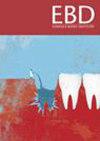Is there a difference in the success rate of pulpotomies in primary teeth when using mineral trioxide aggregate (MTA) compared to other calcium-silicate cements (CSC)?
IF 2.3
Q3 Dentistry
引用次数: 0
Abstract
Silva E J N L D, Pinto K P, Riche F N S J et al. Success of primary teeth pulpotomy using calcium silicate cements: a systematic review and meta-analysis of randomised clinical trials. Pediatr Dent 2024; 46: 373–395. This systematic review and meta-analysis of randomised clinical trials aimed to evaluate and compare the outcomes of pulpotomy procedures using Mineral Trioxide Aggregate (MTA) and other Calcium-Silicate Cements (CSCs). The review protocol was registered with PROSPERO (CRD42023479322) and adhered to PRISMA 2020 guidelines. Two independent reviewers conducted a comprehensive systematic search across PubMed®, Cochrane Library, Scopus, Web of Science™, Embase®, and ScienceDirect®, supplemented by manual searches and OpenGrey. Eligible studies were selected according to the PICOS criteria, including only randomised clinical trials that reported clinical and radiographic evaluations of pulpotomies with a minimum follow-up period of six months. The certainty of evidence was appraised using the GRADE framework, evaluating domains such as risk of bias, inconsistency, indirectness, imprecision, and publication bias. Two reviewers independently assessed the severity of each domain. Meta-analyses were performed using RevMan 5.3, comparing clinical and radiographic success rates of MTA pulpotomies with those of alternative materials, based on dichotomous outcomes and patient recall. Risk of bias was assessed using the Cochrane RoB-2 tool, and the overall certainty of evidence was determined according to the GRADE methodology. A total of 662 articles were initially identified, with 26 studies included after screening and full-text review. Quality appraisal showed seven studies at low risk of bias, two with some concerns, and 17 at high risk, mainly due to poor randomisation, missing intention-to-treat analyses, and high attrition. Despite challenges in radiographic blinding, outcome and reporting biases remained consistently low. Meta-analyses compared pulpotomy outcomes in primary teeth treated with MTA versus other CSCs. No significant differences were observed between MTA and Biodentine™ in clinical success (P > 0.05), though MTA showed higher radiographic success at 12 months (P < 0.05). No significant differences were found between MTA and TheraCal® or Portland cement (P > 0.05). Data were insufficient for analyses by pulpotomy type, tooth type, or irrigant used. The overall quality of evidence was low, due to a serious risk of bias and imprecision. Publication bias appeared minimal, and studies were free from private sector funding. This systematic review and meta-analysis demonstrated that mineral trioxide aggregate (MTA) and other calcium silicate-based cements (CSCs) are effective materials for managing pulpotomies in primary teeth. Although MTA exhibited superior treatment outcomes at 12 months compared to Biodentine™, no significant difference in overall efficacy was observed between the two materials at 24 months. However, the certainty of the evidence supporting these findings was assessed as low, underscoring the need for further research employing robust study designs and extended follow-up periods to achieve a more comprehensive understanding of pulpotomy outcomes with different materials.与其他硅酸钙胶合剂(CSC)相比,使用三氧化二钙骨料(MTA)对乳牙的截髓成功率有何不同?
评论:Silva E J N L D, Pinto K P, Riche F N S J等。硅酸钙骨水泥成功的乳牙切髓:随机临床试验的系统回顾和荟萃分析。儿科Dent 2024;46: 373 - 395。本研究对随机临床试验进行了系统回顾和荟萃分析,旨在评估和比较使用三氧化矿物骨料(MTA)和其他硅酸钙水泥(CSCs)进行髓切开术的结果。方法:审查方案在PROSPERO注册(CRD42023479322),并遵守PRISMA 2020指南。两位独立审稿人对PubMed®、Cochrane Library、Scopus、Web of Science™、Embase®和ScienceDirect®进行了全面的系统检索,并辅以人工检索和OpenGrey。根据PICOS标准选择符合条件的研究,仅包括随机临床试验,这些试验报告了髓质切开术的临床和放射学评估,随访时间至少为6个月。使用GRADE框架评估证据的确定性,评估偏倚风险、不一致性、间隔性、不精确性和发表偏倚等领域。两名评审人员独立评估每个领域的严重性。使用RevMan 5.3进行meta分析,比较MTA髓切术与替代材料髓切术的临床和影像学成功率,基于二分类结果和患者回忆。使用Cochrane rob2工具评估偏倚风险,并根据GRADE方法确定证据的总体确定性。结果:最初共纳入662篇文献,筛选和全文综述后纳入26篇研究。质量评估显示,7项研究存在低偏倚风险,2项存在一些问题,17项存在高风险,主要原因是随机化较差、缺少意向治疗分析和高损耗率。尽管放射学盲法存在挑战,但结果和报告偏差始终保持在较低水平。荟萃分析比较了MTA与其他CSCs治疗的乳牙切牙结果。MTA和Biodentine™在临床成功率方面没有显著差异(P < 0.05),尽管MTA在12个月时的放射学成功率更高(P < 0.05)。数据不充分,无法分析牙髓切开术类型、牙齿类型或使用的冲洗剂。由于严重的偏倚和不精确风险,证据的总体质量较低。发表偏倚似乎很小,而且研究没有得到私营部门的资助。结论:本系统综述和荟萃分析表明,矿物三氧化物聚集体(MTA)和其他硅酸钙基水泥(CSCs)是处理乳牙切髓术的有效材料。尽管MTA在12个月时的治疗效果优于Biodentine™,但在24个月时,两种材料的总疗效没有显著差异。然而,支持这些发现的证据的确定性被评估为较低,强调需要进一步的研究,采用可靠的研究设计和延长随访时间,以更全面地了解不同材料的椎髓切开术的结果。
本文章由计算机程序翻译,如有差异,请以英文原文为准。
求助全文
约1分钟内获得全文
求助全文
来源期刊

Evidence-based dentistry
Dentistry-Dentistry (all)
CiteScore
2.50
自引率
0.00%
发文量
77
期刊介绍:
Evidence-Based Dentistry delivers the best available evidence on the latest developments in oral health. We evaluate the evidence and provide guidance concerning the value of the author''s conclusions. We keep dentistry up to date with new approaches, exploring a wide range of the latest developments through an accessible expert commentary. Original papers and relevant publications are condensed into digestible summaries, drawing attention to the current methods and findings. We are a central resource for the most cutting edge and relevant issues concerning the evidence-based approach in dentistry today. Evidence-Based Dentistry is published by Springer Nature on behalf of the British Dental Association.
 求助内容:
求助内容: 应助结果提醒方式:
应助结果提醒方式:


